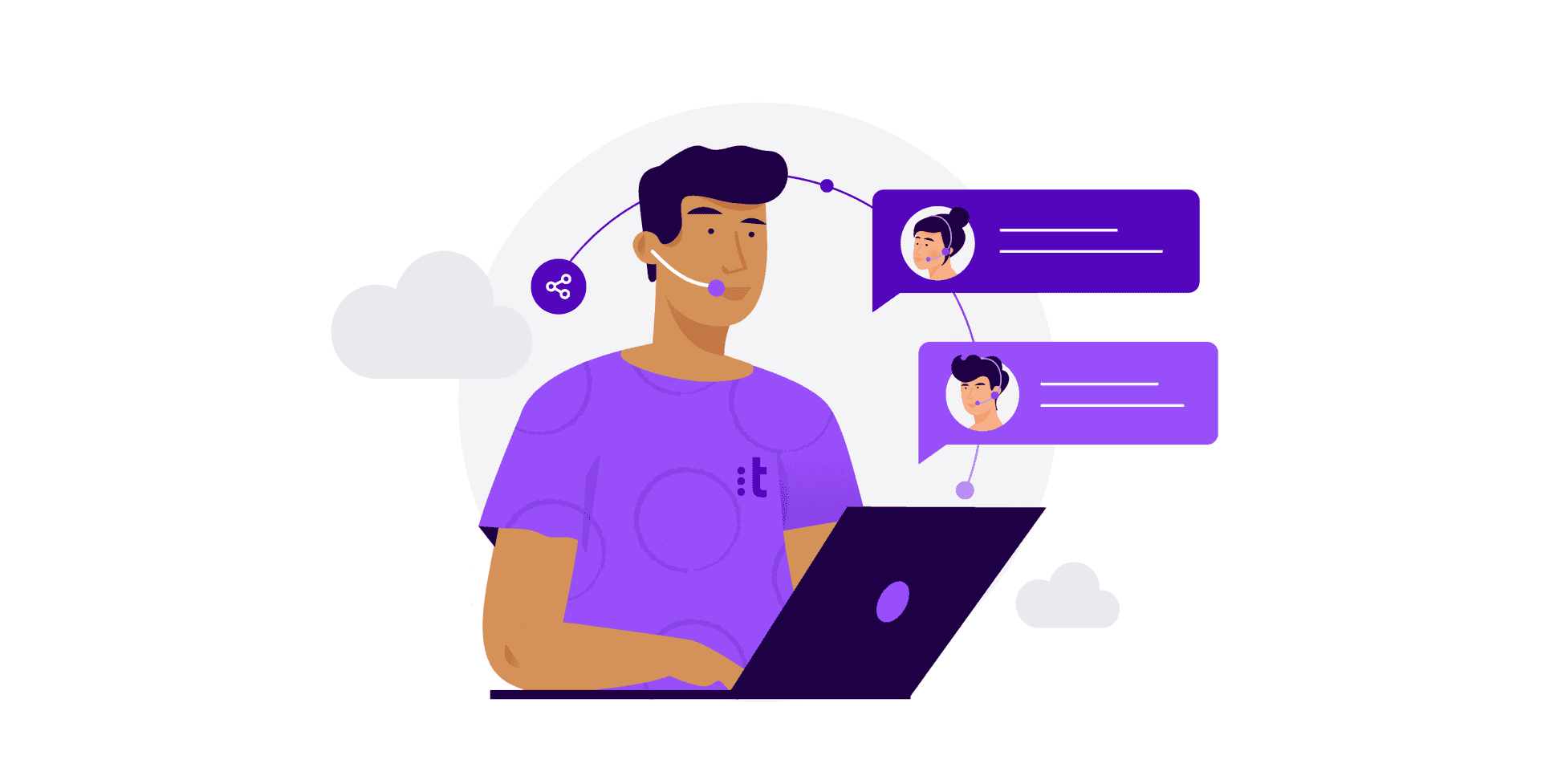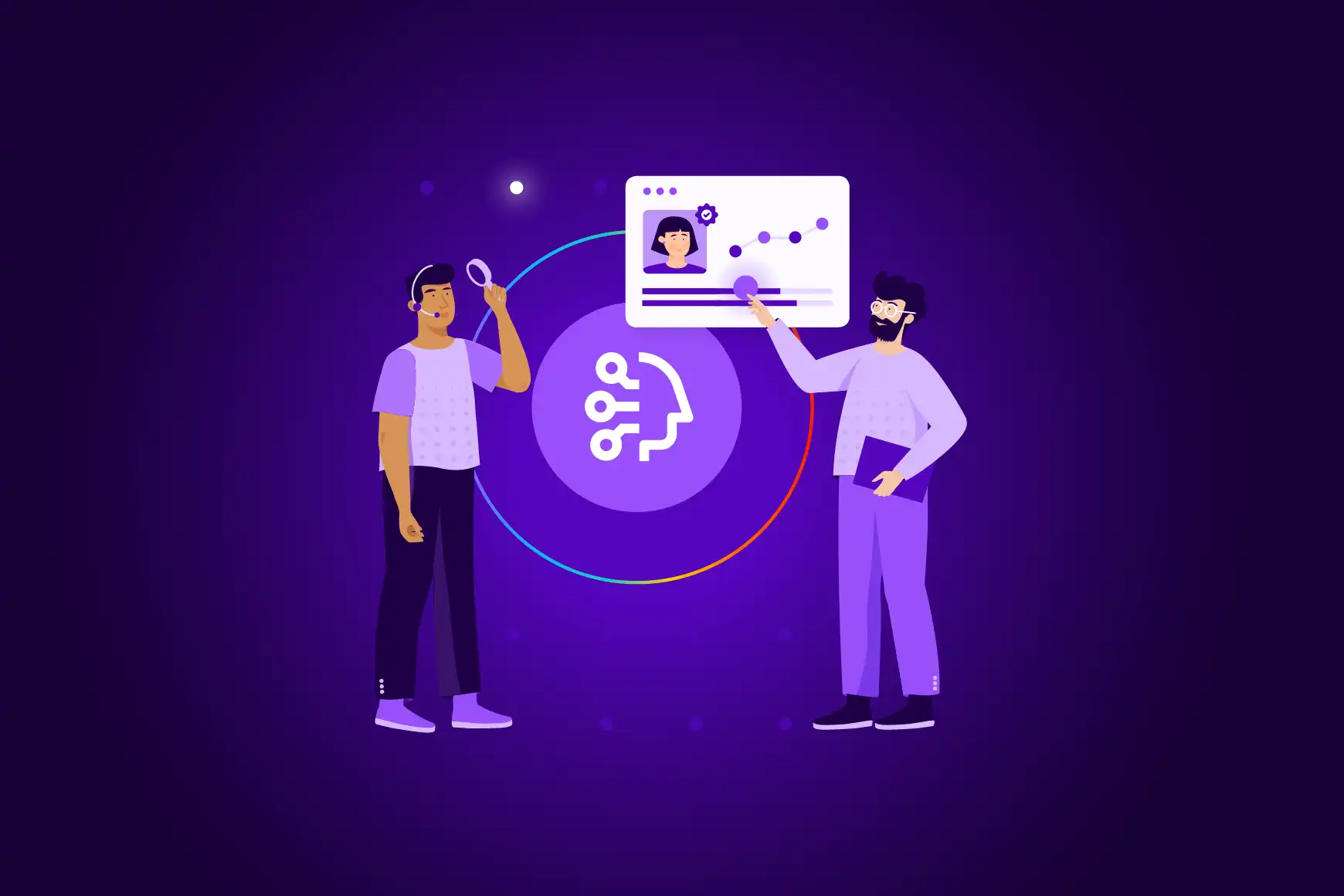What is call center routing and how does it improve customer experience?

By Celia Cerdeira
0 min read

Call center routing is a crucial technology for successfully personalizing customer service and improving performance by assigning the best agent to handle a specific customer issue.
Keep reading to learn more about call routing and its benefits to the improvement of the customer journey.
What is call center routing?
Call center routing is a call management system that automatically places and distributes inbound calls to a specific agent, or ring group, based on predefined rules and criteria. Call routing happens before agents pick up the call.
Call routing systems are also sometimes referred to as automatic call distributor (ACD) because it automatically answers, queues, and distributes calls to agents in addition to playing relevant announcements.
Call routing is triggered by user prompts and call attributes, such as the language of the caller, agent availability, company department, call volume, and more.
Call center routing reduces call waiting times and ensures a seamless customer experience by resolving issues quickly and successfully. Moreover, call routing optimizes call delivery processes, also improving agent empowerment, productivity, and efficiency.
Call center routing: A real world example.
You’ve just received a huge bill from your internet provider. A bit furious, you grab the phone and dial the provider’s number.
The phone system gives you several options:
- Customer service
- Technical support
- Account statements
- Get new service
- Billing questions
All you have to do is press the respective number or say the department name. In this case, that would be “Billing questions.”
The provider’s phone system knows that you are a customer and forwards the call to the team that handles billing, along with all of your information so that a billing agent can quickly and efficiently handle your issue.
This is possible because call routing recognized your number, identified you as their customer, retrieved all of your relevant information, and seamlessly delivered the call along with the information to the most appropriate agent to solve the issue at hand.
How does call routing work?
The method used for call routing depends on the policies of each contact center, but they’re all very similar in the approach. The call routing system automatically takes calls through a routing engine until they are delivered to an agent.
The routing process goes through the following phases:
Qualifying phase.
In most call centers, the first phase of the routing process is to send calls to an IVR (interactive voice response) tool to determine who is the caller and the reason for calling, usually through a series of automated questions.
Call queuing phase.
Depending on the answers of the caller to the automated IVR questions, the call is forwarded to the appropriate queue. ACDs forward calls based on several factors, such as skills, department, priority, or any other policies the contact center has in place.
Call distribution phase.
After the routing system places the calls in the queue, the next phase is to deliver the calls to the most appropriate agents. Similarly to the call queueing phase, the call distribution follows the policies of the contact center. For example, route the call to the agent that has been idle for the longest time.
Call center routing strategies.
Call routing can occur in several ways as call center routing rules vary according to business needs. The most common type of call routing strategy is based on location and time. For example, if a company has call centers on the East and West coasts, evening callers on the East Coast will be routed to the West Coast call center because they’re still in the working hours window. This feature can also be used to route calls to outsourced call centers.
Below are the most common call routing strategies.
Direct call routing.
In direct call routing there is a number (entry point) for each campaign at the contact center. For example, the campaign has a number for sales, another number for customer service, and so on. If customers dial a number and get the busy signal, they need to keep dialing until they reach an available agent. The call is handled by the first agent that is free to talk to the customer.
Automated call routing.
In automated call routing, the phone number is the same for all campaigns. An automated agent, usually an IVR, gathers information from the customer and transfers the customer to the respective campaign. For example, a customer dials a number and the call goes through “press 1 for customer service, 2 for sales, etc. The customer is connected to the agent that first becomes available to handle the call.
Skills-based call routing.
In skills-based call routing several campaigns share the same phone number, but the call routing strategy takes into account the required skills. Calls are delivered according to the defined call center routing rules, such as priorities, agent skills, and others. Routing scripts do call routing according to specific requirements or business needs. Skills-based routing highly improves the customer experience as it matches the customer with the agent that has the highest skills to solve that specific query.
Intelligent call routing.
Intelligent routing routes calls according to defined rules such as priorities, agent skills, geography, and others. For example, routes the call to the agent that has the required skills and that has been idle for the longest time. Routing scripts can access information about the call, the customer, and the size of the queue before making the call routing decision. Intelligent call routing enables companies to segment and prioritize calls according to business needs and service levels, maximizing the overall productivity of the contact center.

EBOOK
Smarter CX: How contact centers are transforming customer experience with AI
Unleash the power of AI in your contact center for seamless customer journeys.
Benefits of call routing.
Call routing is one of the most important contact center features. In fact, it’s crucial to companies of all sizes and industries. From small and medium businesses to large organizations with thousands of customers, all can benefit from effective call routing.
The right call routing strategy helps to boost customer satisfaction (CSAT) by matching the customer to the most skilled agent, improving agent and customer relationships.
Some of the most important benefits are:
1. Increased productivity.
Automated call routing allows agents to focus on what matters: your customers, thus improving customer experience.
2. Reduced waiting times.
Automatically delivers calls to agents as soon as they are available.
3. Increased resolution rates.
The faster calls are delivered, the faster agents can solve customer issues.
4. Improved performance.
Using skills-based call routing, agents will only handle issues for which they have the knowledge, solving queries much faster.
5. Improved customer experience.
Due to increased first call resolution (FCR) rates by routing the call to the most skilled agent.
6. Reduced call abandonment rate.
Placing callers in the right queue and gathering important information motivates customers to keep waiting.
Types of call routing.
To provide the best customer experience possible, your business needs to set up the right type of routing, based on the type of phone calls that your contact center receives. There are five different types of routing that call centers can choose from. Each of them follows a different set of call routing rules and other criteria. By picking the right type of routing for your call center, you help to ensure that each customer gets the right type of service.
Skills-based routing.
Skills-based routing first collects information on a customer’s queries, usually using an IVR system. Then, it routes to the right agent who has the appropriate skill set for answering that particular query.
Least occupied routing.
When using least occupied routing, a phone system automatically routes calls to the agent who has received the least number of calls that day, or who has spent the least amount of time talking to customers.
Time-based routing.
Time-based routing will direct customer calls based on agents who are within an available time zone. This type of call routing enables organizations to grow their international presence and extend their contact center’s business hours.
Percentage routing.
This type of routing distributes calls based on the size of each contact center. It helps businesses that have multiple centers, ensuring that the small ones do not get the same influx of calls as their larger counterparts.
Sequential Routing.
Sequential routing sets up the agents in a specified order to receive calls. It generally means that one agent is the first person to answer calls, and the other team members will “wait in line” behind them. In other words, whenever agent #1 is busy, the calls gets passed to agent #2, and if that agent is busy to #3, and so on.
Closing thoughts.
From direct call routing, automated call routing, skills-based, or intelligent routing, we are far from the manual operators days. Call routing is one of the most important features at the contact center to improve customer experience and inbound customer service. Call routing gives the contact center flexibility and control to decide how to make those improvements.
The right call routing technology empowers non-technical roles in the contact center, such as supervisors or managers, to quickly make changes to the routing strategy using graphical interfaces, to meet the dynamic changes of the customer service campaigns.
Call routing FAQs.
How much does call routing software cost?
The cost of call routing software depends on the number of users and features that your business requires. Fortunately, many call routing software options fall under the Contact Center as a Service (CCaS) category, meaning that they can be delivered as cloud-based applications and generally are cheaper and easier to install than on-premise options.
What is the difference between call forwarding and call routing?
Call forwarding can redirect phone calls to another phone. When someone calls and gets forwarded to another number, they are put on hold until someone is available. Call routing, on the other hand, is more sophisticated. It is a call management feature that can manage multiple incoming calls and automatically route them to several different phones, without putting the caller on hold in the process.

EBOOK
How to Guide: How to improve digital customer experiences
Join the digital transformation journey today! Don’t let your customer service department lag behind the competition. It’s time to step up and embrace digital customer experience solutions that align with evolving consumer preferences.







